
We decide to go inland away from the beaches and the usual haunts of visitors. We want to see the villages that have existed for hundreds or even thousands of years. We decide to go inland because Naxos is the largest, the greenest, and the most fertile of the Cycladic islands, and is renowned for its farming, its crops, its olive trees, its food; it’s the agricultural heart of the Cyclades, and the historic centre of Cycladic culture. This rich land is the reason so many invaders have laid claim to it, and we want to go to the centre of the centre: the villages where ordinary people live, the farmers, the cheese makers, the olive oil producers.
We decide to go inland towards the mountains.
Don’t get me wrong. This journey is not that far off the beaten path, or even at all really, but it’s much less common than going to the beach where most visitors hang out. We want a glimpse of a more authentic Naxos, and there’s a local bus that will take us there.
The bus leaves from Chora for Filoti at 9.30. You can get off the bus in Chalki and walk by rural paths to Filoti; that’s for us! There’s a crowd waiting and the bus fills up quickly until it’s standing room only. On the bus I get chatting with four young women from Toronto who are off to climb Mt Zas, the highest mountain in the Cyclades. That’s not for us, though I wish it could be. It reminds me of my younger days cooking in wilderness big game hunting camps.
Zas is a corruption of Zeus. According to Greek mythology he was raised in secret in a cave on Mt Zas because his father, Cronus, had already eaten five of Zeus’ siblings. Nice.
It’s a half hour ride to Chalki with four stops along the way; I’m so glad we have seats. Our first stop in Chalki is for breakfast. Feeling our way by the tips of our fingers,
we arrive here.
From my notes: We have breakfast at a lovely cafe shaded by vines, then spend an hour wandering around looking for Chalki in Chalki. I have this idea of what I’ll find and can’t find it. I think I’m looking for the Chalki that’s beyond the commercial centre, or a less gentrified Chalki.
Our searching brings us down sweet narrow lanes
and quickly out of the village, past the stubborn remains of ancient buildings,
past great-grandfather olive trees hundreds of years old,
past a small local creature sunning itself,
down dirt lanes bordered by age-old classic stone walls
past grassy fields and plentiful olive groves, with the mountains always a steadfast backdrop,
until we arrive at a decision point:
We feel a bit like we’ve landed in Alice’s Adventures in Wonderland. All that’s lacking is the caterpillar to tell us: One side will make you grow taller, and the other side will make you grow shorter.
I don’t know what makes us turn left, but it brings us to this:
It’s the church of Saint George Diasoritis, a Byzantine church from the 11th century. It’s closed, but I imagine the interior is as lovely as the Orthodox church of equal age at the top of the hill in Chora. Attesting to its importance in the Byzantine Empire (300-1207), Naxos is peppered with over two hundred churches from that era.
We make our way back, and suddenly there is Chalki, which seems equal parts crumbling-ancient and prosperous-modern, all flagstone streets and neo-classical mansions, some restored, some not. I think I’d been expecting something more earthy, more farm-community, less affluent; if I’d known it had been the capital of a Venetian Duchy for three hundred years I’d have expected something closer to what we see. I’ve written before about expectations, but they get me every time.



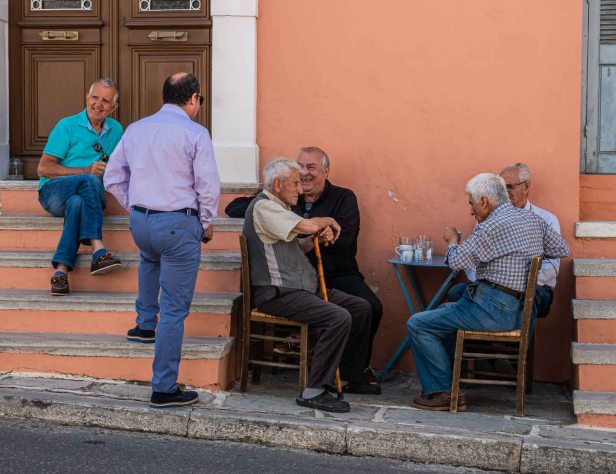

We are then finally on our way to Filoti, walking past ancient stone walls,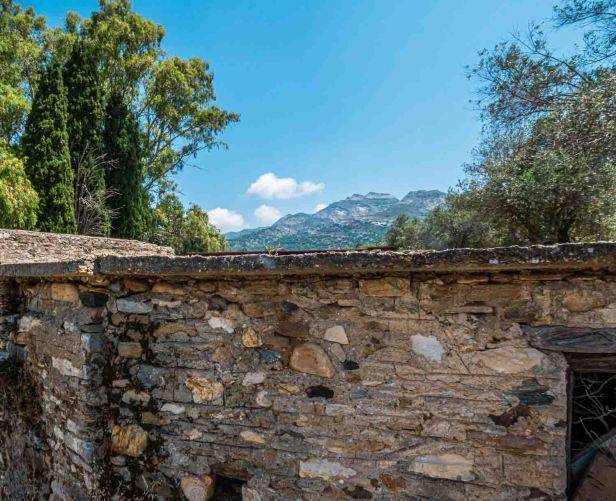
by grassy fields, down narrow rural paths, and crossing a makeshift foot bridge over a small stream.
Again in the clear, we look across a field see this impressive but strange building.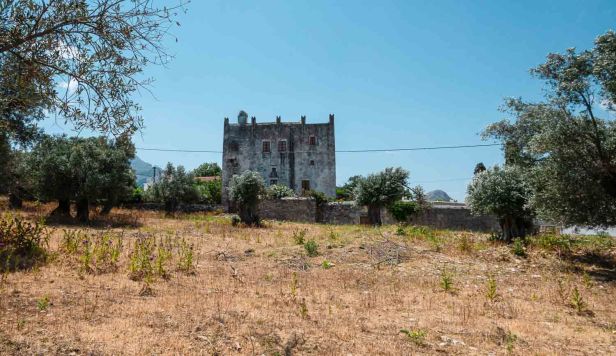
What is it? Who’s responsible for this fearsome building? It’s a building that says I’m here to stay. Don’t mess with me. It’s a building that dares you to be unimpressed. I’d seen something similar in Chalki, and now here’s another one. I’m amused by the funny little crenelation things at the top as if it’s trying to be a castle but can’t quite make it.
From 1207, when Marco Sanudo captured the island, Naxos was under Venetian rule for over three hundred years. Sanudo conquered Naxos and ten other islands of the Cyclades Archipelago. He declared himself Duke of Archipelago, with Naxos as the capital. It drastically changed the lives of Naxians as they were now forced to live under the oppression of a foreign power. There are thirty of these defensive towers on Naxos alone, built by the Venetians to keep themselves separate and safe from the people they ruled. The towers were also used as an early warning system. A fire would be lit on the roof of the tower nearest a raid or uprising, which sent a signal to the next tower, where a fire was lit sending the signal to the next tower, and so on. Some towers were monasteries, and some were summer houses of Venetian nobles. But this particular tower, mimicking the Venetians, was actually built by Markakis Politis, a Greek, in the 18th century. It was a bastion of the revolts against the Frankish feudal lords, but Politis was finally captured, exiled to Lesvos, and hanged by the Turks. I guess he wasn’t here to stay after all.
Moving on, unknowingly in the wrong direction, we come to little Kaloxylos, a sliver away from Chalki.

It’s a pretty hamlet, built on the side of a hill, surrounded by olive groves, plane trees, and oaks, and home to the Kaloxylos Folklore Museum full of items relating to the history and culture of Naxos.
We don’t linger. We’re still very close to Chalki trying to find our way to Filoti by the rural lanes. We walk around in circles, past typical Cycladic architecture, past the local church, past this whimsical house with its trompe-l’oeil door,
and find ourselves back in front of the museum. And that’s when I remember maps.me! Google maps is useless for off-road directions, but maps.me is amazing for it. Although it is now much more, I think it began as an app for exactly that – hiking and walking trails. Either way, it’s much better than Google maps or Apple maps for off-road trails. With maps.me we are finally on our way.
We walk along shaded country lanes,
past chicken coops,
past olive groves and Byzantine churches,
along paved rural back-roads, more shaded dirt lanes, and then suddenly, unexpectedly, find ourselves in the hamlet of Kerami, where someone loves very bright colours,
and where Markakis Politis has another tower.
Beyond Kerami we come to views over Tragea, the beautiful valley that is home to all these villages, with Mt Zas in the centre, defining the skyline.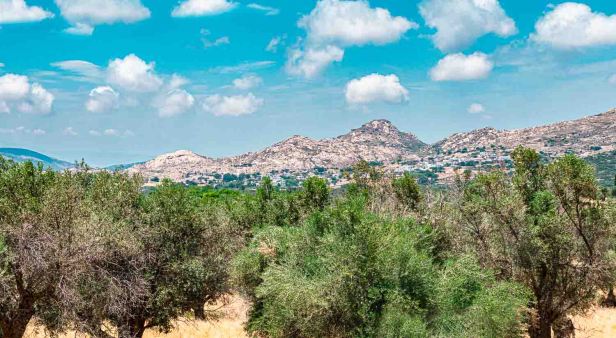
The trail takes us more or less parallel with the road but above it and always with Mt Zas looming. As we walk by the olive groves we can sometimes see the road below. Then at last we see Filoti in the distance spread out before us.
Descending and following the road for a while, we finally arrive.
Filoti is the largest village in the Cyclades, and although it has the biggest population there are still more sheep here than people, and many of the residents are shepherds and goatherds.
Exploring the town a little we find our way to the richly and beauteously decorated Panagia Filotitissa church,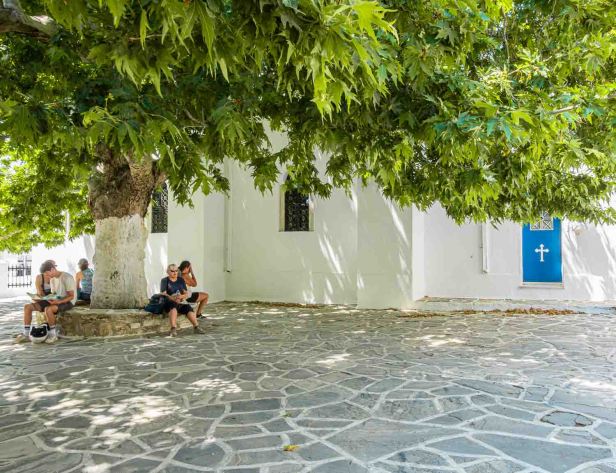


and amble along the lanes and byways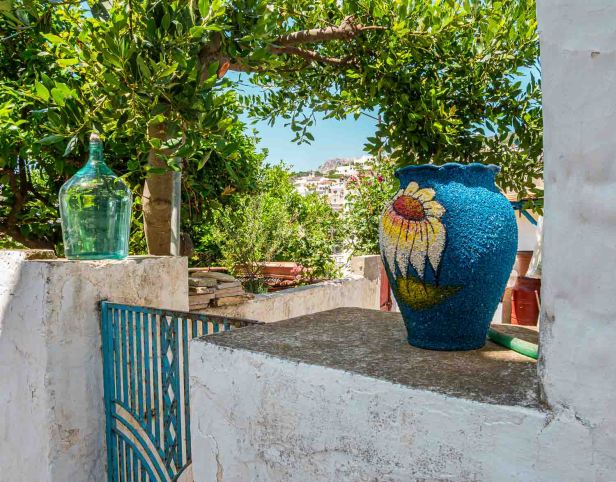
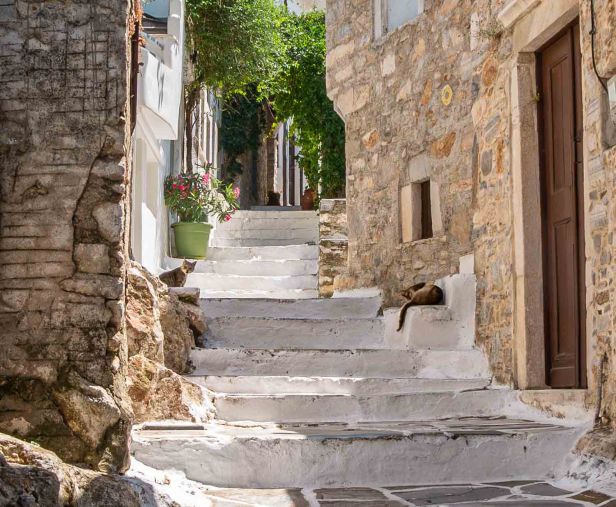
of this town stacked up against the lower slopes of the mountain.
We find the unmistakable Barozzi Tower, dating from 1650, still standing at the heart of the village. Barozzi was by all accounts one of the most oppressive and evil of the Venetian overlords, but today all that’s left is this big ugly building.
The age of the building is truly apparent in the elaborate but rusted gates; beauty from a bygone age.
Eventually we return to the main “square” with its enormous plane tree to wait for the bus.
From Don’s notes: Although we’re among the first to get to the bus stop, the bus pulls up past where we’re standing and Ali has to do one of her quarterback sneaks to get to the front of the line and secure us seats. I begin to worry if I’m going to be able to get onto the bus, but eventually I do. The bus ends up completely filled, but we have a relaxed ride back to town.
As I watch the crowd surging forward I’m also a bit worried that Don won’t be able to get on the bus, and am relieved when he does. After a half hour or so we can see Chora on the horizon.
From Don: In Chora we drag ourselves along the seafront and stop briefly at a bakery and at a supermarket. We’d arranged to meet with the owner of Studios Stratos to ask for a late checkout and luggage storage until it’s time for the ferry the next day. This is cheerfully granted, then the owner regales us with a long complicated story about her encounter with a South African guest who, she found out from the guest, killed crocodiles for a living and sold the chest plate to Louis Vuitton to make expensive shoes and bags. She had a bad feeling about this guest, and after he left she smudged his room with incense to drive out the bad energies. We’re in complete sympathy with her actions, but are ready for dinner, so we make our apologies and head back to our room. Dinner is the same as last night: lettuce, tomato, cucumber, slices of ham and cheese, with bread and butter. Simple but delicious.
And thus ends our day lost in the villages of Naxos.

Coming up: Naxos is ringed with golden beaches and we hang out at two of them.
All words and images by Alison Louise Armstrong unless otherwise noted
© Alison Louise Armstrong and Adventures in Wonderland – a pilgrimage of the heart, 2010-2023.

What a quaint, lovely place in a splendid geography. xo
LikeLiked by 1 person
Isn’t it lovely! We so enjoyed this little exploration. I wish we’d had more time in Greece all together, and looking at how far we walked on this day with one more day on Naxos and we’d have been able to climb Mt Zas.
Alison
LikeLike
Lovely pics and very cool dual narrative. Thephotos of villages in this piece make me more than ready to go back to France and Catalonia… but I will have to wait until August 29th. Take care
Keith
LikeLiked by 1 person
Thanks so much Keith. European villages are so enticing. I’ve not spent that much time in Europe, and having been raised in Oz and living in Canada, this kind of age and history is still exotic to me. Exotic and charming and enticing. So I understand your desire to get back to Catalonia and France.
Alison
LikeLike
What a wonderful day you had – Beautiful views and getting off the beaten path. I also visited Filote last year, after scaling Mt. Zas with a couple from Quebec that I met! 🤪 it was hot and tough. The cave was very interesting and cool. It was so hot when I was there. I also took a day bus trip tour around the island, which was great, as I didn’t rent a car. The public buses were so easy to catch and get you to off the road places. Thanks for the wonderful memories! ❤️
LikeLiked by 1 person
I’m glad I brought back some good memories for you! I wish we’d had more time there. We could have climbed Mt Zas I think (looking at height and distance, and compared to what we did to get to the villages, and also in other places), and the bus trip around the island sounds great. So much world so little time. Sigh.
Alison
LikeLike
Makes me remember how drop dead gorgeous the Cyclades are. We did briefly consider Greece for our ‘place in the sun’ but winter climate isn’t so reliable. On Naxos we took a local bus but I can’t remember where we ended up, apart from dropping off a priest at his home. Did you go to Paros too? I have wonderful memories of Naousa.
LikeLiked by 1 person
The Cyclades are so beautiful aren’t they! Special and really unique. We got to three of them this trip, plus Crete. Maybe we’ll get back one day. We didn’t get to Paros. After Naxos we went to Milos which was really fabulous – our fave of the three.
Alison
LikeLiked by 1 person
Does this day’s adventure count as coddiwompling? Maybe not, as your destination was not vague. But I think, in spirit, it’s a coddiwomple adventure.
For some reason I had not though the trunks of olive trees could get so HUGE! They look like the toilet roll dolls kids make, all thick bodies and copious amounts of hair. Perhaps a muppet?
That tower is truly ugly; isn’t it sad when the ugly things survive and the beautiful ones are lost?
Fav pics: a tie between “two roads converged” and the small Byzantine church. Oh, and the one with the peachy-orange stairs, hot pink flowers, and guy in the purple dress shirt. (I did read to the end of the article, I swear!)
LikeLiked by 1 person
Oh I think it could be for sure at least a sibling of coddiwompling; destination was not vague, but getting there certainly was 😂
Aren’t those ancient olive trees amazing! I’ve never seen anything like it but one site I read implied they could be thousands of years old. I guess they keep pruning the old dead branches and the tree just grows new ones out the top.
All the Venetian towers were much the same and all ugly. Strange given how elegant Venetian architecture is in other places like Croatia.
Your photo pics are a fine choice, and unique as usual. Of the three you chose I like the church best I think (such beautiful colours and design), but overall my fave is the one of Chora in the distance. Love the light in that one.
Alison
LikeLike
One thing that surprised me about my travels is that I really like churches, the more out of the way and small, the better. I’m not at all religious, but there is something about the peace and serenity and striving for beauty and the good parts of humanity in churches that makes me happy. And the craftmanship, of course!
LikeLiked by 1 person
Yes. All of this. It’s especially the small local ones. Also found the same with Buddhist temples in Asia. So much devotion and serenity in places like this. It’s reduced me to tears a few times.
LikeLike
You two sure do know how to explore. Love the colours of Kerami.
LikeLiked by 1 person
We do love to explore for sure so always try to find ways. I guess it shows 😂
I was amazed by that house in Kerami; I’ve never seen anything like it, and it was certainly not typical.
Alison
LikeLiked by 1 person
I could almost feel the relaxed atmosphere of those villages through your photos, Alison. I like the look of the cafes you found along the way, the cats, the small churches, the bright flowers, the old buildings, and those olive trees that seem ancient!
LikeLiked by 1 person
Oh good, I’m glad you got a bit of a feel for the villages. They seemed very laidback and peaceful even if we were a bit too focused on simply finding our way. We ended up walking 11 km that day! We could have climbed Mt Zas! (9km – just a stroll really 😂)
The cafes, church, cats, little back alleys – it was all lovely and I’m really glad we went.
Aren’t those olive trees amazing! They actually could be thousands of years old!
Alison
LikeLiked by 1 person
Reading through this I get the sense, this is the difference between being a traveler and being a tourist. You do the former, we, more the later.
LikeLiked by 1 person
I think there’s something to what you say. We love to go exploring. We go to the “touristy” places too. There’s always a reason they’re so popular – it’s because they’re worth seeing, but beyond that we’re always looking for places where ordinary life happens.
I also think everyone has their own travel style, and one is not better than another.
Alison
LikeLiked by 1 person
What delightful treasures you found! These villages are what I love best about travelling. And those wonderful churches! I thoroughly enjoyed this hike with you and Don.
LikeLiked by 1 person
Thanks so much Darlene, glad you enjoyed coming along. It was such a confusing, but rewarding exploration – every time we went around in circles we discovered something new. And yes, that church in Filoti – what a beauty!
Alison
LikeLiked by 1 person
Alison, Your images are thoughtfully composed with a great variety of subjects. They tell an interesting story and gives a great sense of place. Wonderful post of this charming and colorful island!
LikeLiked by 1 person
Thank you so much Jane. It was a fabulous, if at times confusing, day. And each time we were lost we saw more of the area and villages, so it ended up being a grand exploration. By the end we were exhausted! But it was definitely worth it.
Alison
LikeLiked by 1 person
Oh, boy – my kind of day … lots of ambling and lots of eye candy along the way. I’ve just returned from Italy and am wondering why I just don’t move to Europe! 🙂 They’ve got the whole combo: history, beauty, soooo many walks. Lovely day and post – thank you!
LikeLiked by 1 person
Thanks so much Lexie. Naxos was fabulous in so many ways – Venetian old town, inland villages, and amazing beaches. And yes loads of great walks – that we read about but this one was all we had time for.
I would *love* to see more of Europe! Maybe one day . . . .
Looking forward to your posts about Italy!
Alison
LikeLiked by 1 person
Great discoveries, I would love to wander in those ancient towns.
LikeLiked by 1 person
It was overall a good exploration. We were determined not to walk on the road but to find the age-long local paths between the villages. So that was fun if frustrating at times, and the villages were lovely.
Alison
LikeLiked by 1 person
You’ve had a more authentic view of the area than other that visit, I’m sure.
LikeLiked by 1 person